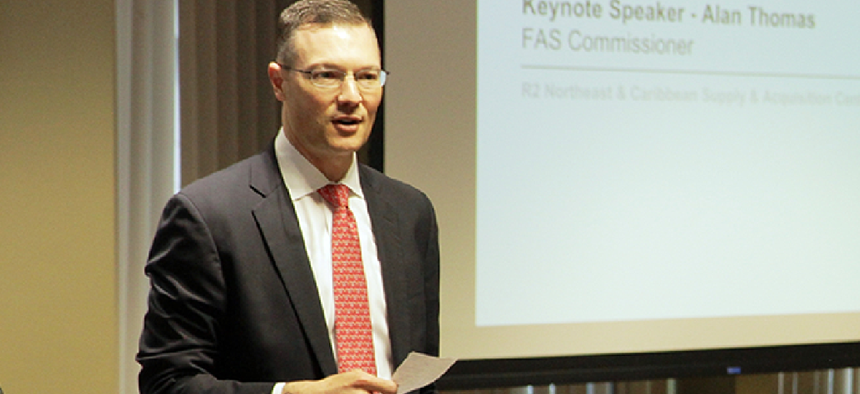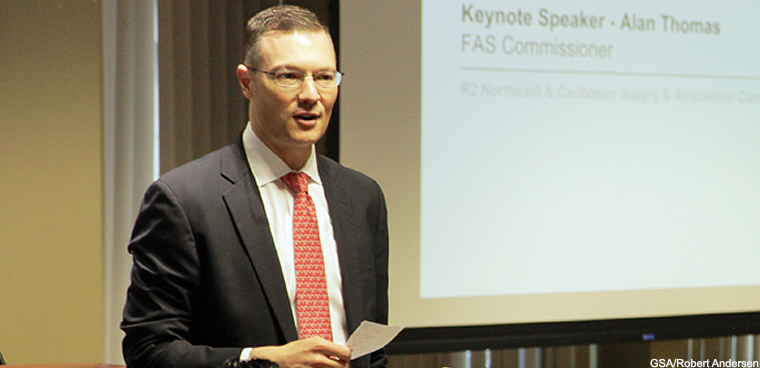COMET, EIS moving ahead at GSA

Federal Acquisition Service head Alan Thomas is retiring just as two major overhauls are showing results.

Outgoing FAS Commissioner Alan Thomas shown here in June 2018
The General Services Administration plans a task order for the agency's contract writing system in the first quarter of this fiscal year through its recently-awarded CIO Modernization and Enterprise Transformation (COMET) blanket purchase agreement.
Alan Thomas, the outgoing commissioner of the Federal Acquisition Service, said the contract writing system is one of the "big push" items for FAS in the near term.
The 12 COMET awardees will bid on the task order. The contract writing system, Thomas said, will give contracting officers a new tool that will help save time in traversing various GSA systems to pull together contracts.
On the sidelines of a Nextgov IT modernization conference on Oct. 8, Thomas told FCW that his last day at FAS is Oct. 11 and declined to say where he's going next, but did say that his new job would be in the Washington D.C. area and in the government market.
Another "big push" for FAS modernization is a little further down the road, according to Thomas. The agency is in the "blueprint" stage of developing a common catalog for its thousands of products and services.
"We've settled on a strategy. The goal is to take a chunk of this fiscal year and get the requirements together and get the requirements together and bid it out through COMET this fiscal year," he said.
EIS progress
Thomas also said he was encouraged with the progress agencies are making in using Enterprise Infrastructure Services, the $50 billion telecommunications contract run by GSA, and noted that a coming deadline could add some incentive.
On March 31, GSA will begin limiting agency access to extended legacy telecommunications contracts to push them towards the Enterprise Infrastructure Solutions contract. The milestone is one of three that GSA set late in 2018 when it extended its original 2020 deadline for agency transition to EIS to 2023 after federal agencies were slow to issue initial solicitations for the contract.
"We mentioned it at the last President's Management Council meeting," he said. GSA officials at the meeting brought along a "stop light chart" of where CFO Act federal agencies stood on EIS. "We're raising it at the highest level we can."
Agency task orders for EIS haven't flooded in to GSA, even though Sept. 30 was GSA's deadline for federal agencies to issue them. Just before that deadline, the IRS and the Social Security Administration issued task orders to Verizon and CenturyLink for EIS services.
Even with the two large agencies making it just under the September deadline wire, Thomas said there hasn't been a "flood" of task orders for EIS. He said he was encouraged not only by the IRS and SSA task orders, but also by progress carrier vendors are making at getting their Authorities to Operate under EIS.
Four smaller EIS vendors have yet to get their ATOs and can't officially provide services. Thomas said two will likely get ATOs by Thanksgiving, and the remaining two by the end of the calendar year.
As for EIS transition, Thomas is largely content.
"It could always be faster. It's a shared responsibility we have with the agencies. We can push. We can offer incentives and sticks. It's complex. Each agency CIO's got a different set of to-do's. For some, it's at the top of their list. Others say 'that's important, but I have three other things my boss tells me I have to do before that.'"
NEXT STORY: NASA's big contract vehicle lowers fee


